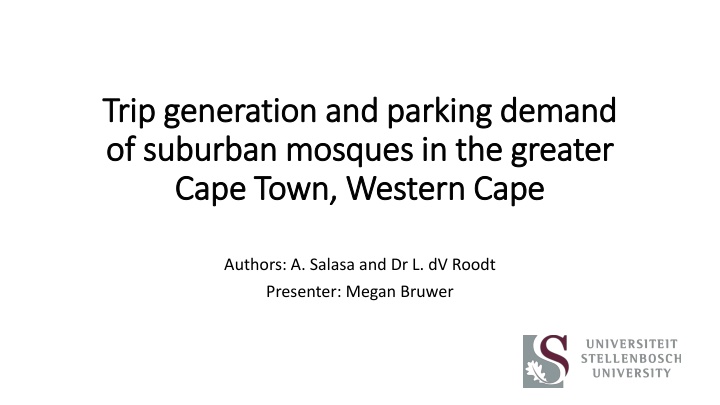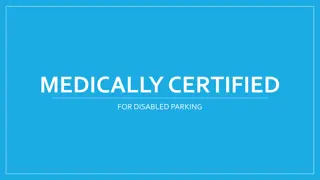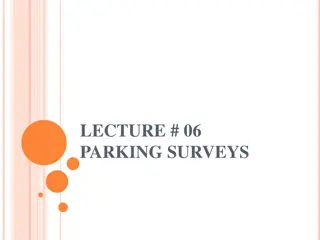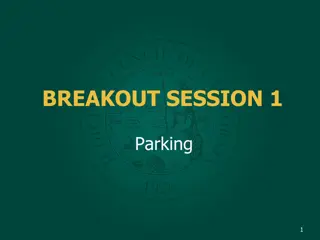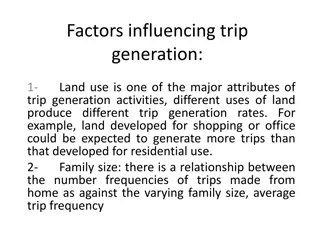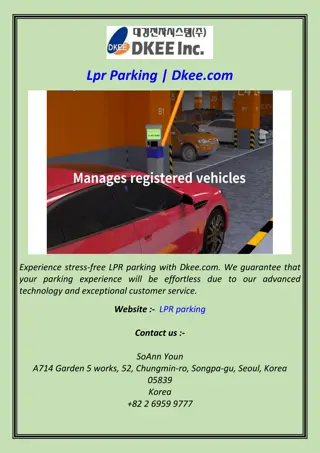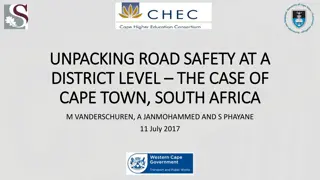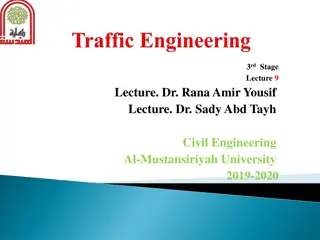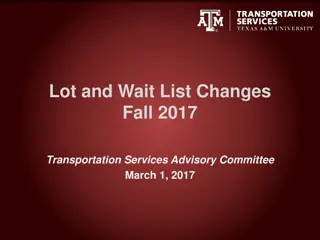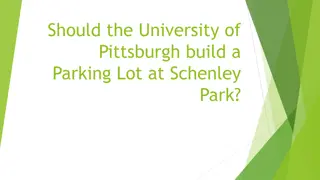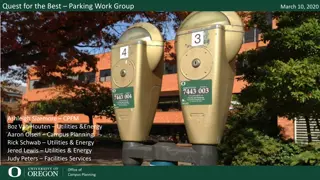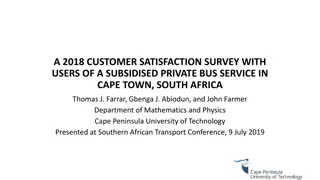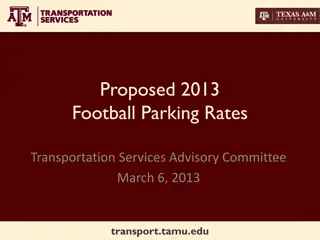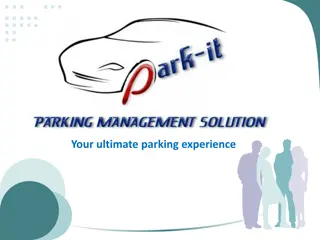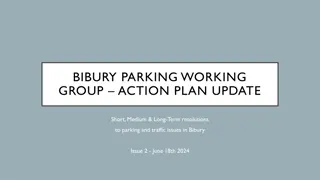Trip Generation and Parking Demand of Suburban Mosques in Greater Cape Town
Study on trip generation and parking demand specific to suburban mosques in Greater Cape Town, focusing on developing local trip generation rates using methodologies adapted to local conditions.
Download Presentation

Please find below an Image/Link to download the presentation.
The content on the website is provided AS IS for your information and personal use only. It may not be sold, licensed, or shared on other websites without obtaining consent from the author.If you encounter any issues during the download, it is possible that the publisher has removed the file from their server.
You are allowed to download the files provided on this website for personal or commercial use, subject to the condition that they are used lawfully. All files are the property of their respective owners.
The content on the website is provided AS IS for your information and personal use only. It may not be sold, licensed, or shared on other websites without obtaining consent from the author.
E N D
Presentation Transcript
Trip generation and parking demand Trip generation and parking demand of suburban mosques in the greater of suburban mosques in the greater Cape Town, Western Cape Cape Town, Western Cape Authors: A. Salasa and Dr L. dV Roodt Presenter: Megan Bruwer
1. Introduction DOT & COTO: TMH 17 ITE: Trip Generation Manual TMH 17 does not provide trip generation rates specifically for mosques Uses of a mosque differ greatly from that of a church It is important to develop specific local trip generation rates
1. Introduction ITE Vehicle Trip Generation Rates Unit Description (Square feet) Weekday AM PM Church 1000 9.11 0.56 0.55 Synagogue 1000 10.64 0.14 1.69 Mosque 1000 NA 1.63 11.02 Note: 1000 square feet = 92.3 square metre
2. Methodology Combination of: Institute of Transportation Engineers (ITE) trip generation studies Committee of Transport Officials (COTO) trip generation studies ITE trip generation study in Al-Khobar, Saudi Arabia The survey method adapted to local conditions
2. Methodology cont Breakdown of mosques in SA Suburban Rural CBD/Urban
2. Methodology cont Breakdown of mosques in SA Suburban Rural CBD/Urban Jumua Non-Jumua
2. Methodology cont Steps for suburban mosques: 1. The first step in a survey is to determine the critical day and time Jumua mosques: Friday between 12:45 PM and 1:45 PM Non-Jumua mosques: Between 6:30 PM and 7:30 PM on weekends
2. Methodology cont Steps for suburban mosques: 1. The first step in a survey is to determine the critical day and time Jumua mosques: Friday between 12:45 PM and 1:45 PM Non-Jumua mosques: Between 6:30 PM and 7:30 PM on weekends 2. Identify suitable mosques to survey
2. Methodology cont Steps for suburban mosques: 1. The first step in a survey is to determine the critical day and time Jumua mosques: Friday between 12:45 PM and 1:45 PM Non-Jumua mosques: Between 6:30 PM and 7:30 PM on weekends 2. Identify suitable mosques to survey 3. Selecting suitable independent variables ITE 2012: Floor space (area) Available prayer spaces
2. Methodology cont Steps for suburban mosques: 1. The first step in a survey is to determine the critical day and time Jumua mosques: Friday between 12:45 PM and 1:45 PM Non-Jumua mosques: Between 6:30 PM and 7:30 PM on weekends 2. Identify suitable mosques to survey 3. Selecting suitable independent variables ITE 2012: Floor space (area) Available prayer spaces Mosques operate over capacity
2. Methodology cont Steps for suburban mosques: 1. The first step in a survey is to determine the critical day and time Jumua mosques: Friday between 12:45 PM and 1:45 PM Non-Jumua mosques: Between 6:30 PM and 7:30 PM on weekends 2. Identify suitable mosques to survey 3. Selecting suitable independent variables ITE 2012: Floor space (area) Available prayer spaces Mosques operate over capacity Number of Muslim households in the surrounding area
2. Methodology cont Steps for suburban mosques: 1. The first step in a survey is to determine the critical day and time Jumua mosques: Friday between 12:45 PM and 1:45 PM Non-Jumua mosques: Between 6:30 PM and 7:30 PM on weekends 2. Identify suitable mosques to survey 3. Selecting suitable independent variables ITE 2012: Floor space (area) Available prayer spaces Mosques operate over capacity Number of Muslim households in the surrounding area Total prayer floor area
2. Methodology cont Steps for suburban mosques: 1. The first step in a survey is to determine the critical day and time Jumua mosques: Friday between 12:45 PM and 1:45 PM Non-Jumua mosques: Between 6:30 PM and 7:30 PM on weekends 2. Identify suitable mosques to survey 3. Selecting suitable independent variables ITE 2012: Floor space (area) Available prayer spaces Mosques operate over capacity Number of Muslim households in the surrounding area Total prayer floor area Number of worshippers
2. Methodology cont Steps for suburban mosques: 1. The first step in a survey is to determine the critical day and time Jumua mosques: Friday between 12:45 PM and 1:45 PM Non-Jumua mosques: Between 6:30 PM and 7:30 PM on weekends 2. Identify suitable mosques to survey 3. Selecting suitable independent variables ITE 2012: Floor space (area) Available prayer spaces Mosques operate over capacity Number of Muslim households in the surrounding area Total prayer floor area Number of worshippers 4. Identify any environmental factors
2. Methodology cont Steps for suburban mosques: 1. The first step in a survey is to determine the critical day and time Jumua mosques: Friday between 12:45 PM and 1:45 PM Non-Jumua mosques: Between 6:30 PM and 7:30 PM on weekends 2. Identify suitable mosques to survey 3. Selecting suitable independent variables ITE 2012: Floor space (area) Available prayer spaces Mosques operate over capacity Number of Muslim households in the surrounding area Total prayer floor area Number of worshippers 4. Identify any environmental factors 5. Survey the mosques
2. Methodology cont Parking demand Number of parking spaces required Drop-off parking was omitted Parking demand = vehicular demand trips One vehicular demand trip equals to the demand for one parking bay Based on the same independent variables as the trip generation rates
3. Survey results of Jumua mosques Table 2: Survey results summary of Jumua mosques Jumua mosque Total house- holds 110 ? 120 85 600 No. of prayer spaces 200 300 300 1000 2000 Approximate prayer floor area m2 144 216 216 720 1440 No. of vehicles (Local) 68 160 63 83 468 No. of vehicles (Other) 37 28 29 42 54 Total vehicles No. of worshippers Blue Downs Faure Street Macassar *Faure Kramat **Nolte Street 105 188 92 125 522 240 320 330 320 2150 * Faure Kramat mosque has a large floor space relative to the households served as it is a shrine to Shaykh Yusuf of Macassar (1626 -1699) and a place of pilgrimage. **Nolte Street mosque is in a predominantly Muslim area close to a local CBD
4. Trip generation rates of Jumua mosques Table 3: Calculated trip generation rates and parking demand of Jumua mosques Trip generation per household Standard deviation 0.08 Samples Split (in:out) Average rate Range of rates 3 Samples Trip generation per prayer space 100 in : 0 out 0.86 0.77 - 0.95 Standard deviation 0.15 Samples Split (in:out) Average rate Range of rates 4 100 in : 0 out 0.43 0.26 - 0.63 Trip generation per 100 m2 prayer floor area Standard deviation 21.0 Samples Split (in:out) Average rate Range of rates 4 100 in : 0 out 59.7 36 - 87 Trip generation per worshipper Standard deviation 0.12 Samples Split (in:out) Average rate Range of rates 5 100 in : 0 out 0.39 0.24 0.59
4. Trip generation rates of Jumua mosques cont The number of worshippers was also used to relate to the independent variables and found to be: 3.5 worshippers per household 1.1 worshippers per prayer space 150 worshippers per 100 m2
4. Trip generation rates of Jumua mosques cont The number of worshippers was also used to relate to the independent variables and found to be: 3.5 worshippers per household 1.1 worshippers per prayer space 150 worshippers per 100 m2 The ratios of vehicles from areas outside the mosque vehicle registration zone were calculated 3 of the mosques attracted between 32% and 36% of vehicles from outside 2 attracted only 11% to 15%
5. Survey results of Non-Jumua mosques Table 4: Survey results summary of Non-Jumua mosques Non-Jumua mosque Total number of vehicles parked at the mosque 7 36 3 Number of prayer spaces Approximate prayer floor area (m2) Sandvlei Gustrouw Broadlands 130 400 70 93.6 288 50.4
6. Trip generation rates of Non-Jumua mosques Table 5: Calculated trip generation rates and parking demand of Non-Jumua mosques Trip generation/parking demand per prayer space Number of samples 3 100 in : 0 out Trip generation/parking demand per 100 m2 prayer floor area Number of samples 3 100 in : 0 out Standard deviation 0.025 Split (in:out) Average rate Range of rates 0.062 0.043 0.090 Average rate 8.64 Standard deviation 3.43 Split (in:out) Range of rates 5.95 12.50
7. Discussion & conclusions Jumua mosques Number of households in the area increased, the number of vehicles that originated from an outlying area decreased
7. Discussion & conclusions cont Jumua mosques Number of households in the area increased, the number of vehicles that originated from an outlying area decreased Trip attraction = Parking demand
7. Discussion & conclusions cont Jumua mosques Number of households in the area increased, the number of vehicles that originated from an outlying area decreased Trip attraction = Parking demand Directional split in the peak hour was 100:0 (In:Out)
7. Discussion & conclusions cont Jumua mosques Number of households in the area increased, the number of vehicles that originated from an outlying area decreased Trip attraction = Parking demand Directional split in the peak hour was 100:0 (In:Out) Trip generation rate: 0.86 trips/household
7. Discussion & conclusions cont Jumua mosques Number of households in the area increased, the number of vehicles that originated from an outlying area decreased Trip attraction = Parking demand Directional split in the peak hour was 100:0 (In:Out) Trip generation rate: 0.86 trips/household Trip generation rate: 0.43 trips/prayer space Trip generation rate: 0.39 trips/worshipper
7. Discussion & conclusions cont Jumua mosques Number of households in the area increased, the number of vehicles that originated from an outlying area decreased Trip attraction = Parking demand Directional split in the peak hour was 100:0 (In:Out) Trip generation rate: 0.86 trips/household Trip generation rate: 0.43 trips/prayer space Trip generation rate: 0.39 trips/worshipper Trip generation rate: 59.7 trips/100 m2 prayer floor area
7. Discussion & conclusions cont Non-Jumua mosques Trip generation rate: 0.062 trips/prayer space
7. Discussion & conclusions cont Non-Jumua mosques Trip generation rate: 0.062 trips/prayer space Trip generation rate: 8.64 trips/100 m2 prayer floor area
7. Discussion & conclusions cont Non-Jumua mosques Trip generation rate: 0.062 trips/prayer space Trip generation rate: 8.64 trips/100 m2 prayer floor area Capacity in excess of 40 prayer spaces should be subject to traffic impact assessments or studies as it can be assigned to be a Jumua mosque Islamic law requires more than 40 adult males for a Jumua prayer meeting
8. Recommendations Suburban mosques Average trip generation rates from a design point of view
8. Recommendations cont Table 6: Proposed design values for trip generation and parking demand for suburban mosques with a capacity of more than 40 prayer spaces Vehicle trip generation rate Parking demand 1 0.6 80 Per Muslim household Per prayer space Per 100m2 prayer floor space 1 0.6 80
8. Recommendations cont Suburban mosques Average trip generation rates from a design point of view Directional distribution is 100% in during the peak hour on Friday between 12:45 PM and 1:45 PM Parking demand peaks at 1:00 PM
8. Recommendations cont Suburban mosques Average trip generation rates from a design point of view Directional distribution is 100% in during the peak hour on Friday between 12:45 PM and 1:45 PM Parking demand peaks at 1:00 PM Mosques with less than 40 prayer spaces (30 m2)
9. References Al-Fouzan, S.A., 2010. Parking provision requirements according to type of land use in major Saudi Arabian cities. Dirasat: Engineering Sciences, 36(2). COTO. 2013. South African Trip Data Manual, TMH 17. Committee of Transport Officials. Pretoria: The South African National Roads Agency Limited Institute of Transportation Engineers. 2012. Trip Generation Manual. 9th Edition. Washington D.C. Ratrout, N.T., 2009. Estimating Grand Mosque Attraction of Vehicular Trips. Institute of Transportation Engineers. ITE Journal, 79(6), p.40.
Thank you Contact: Dr Louis Roodt (ldvroodt@sun.ac.za)
